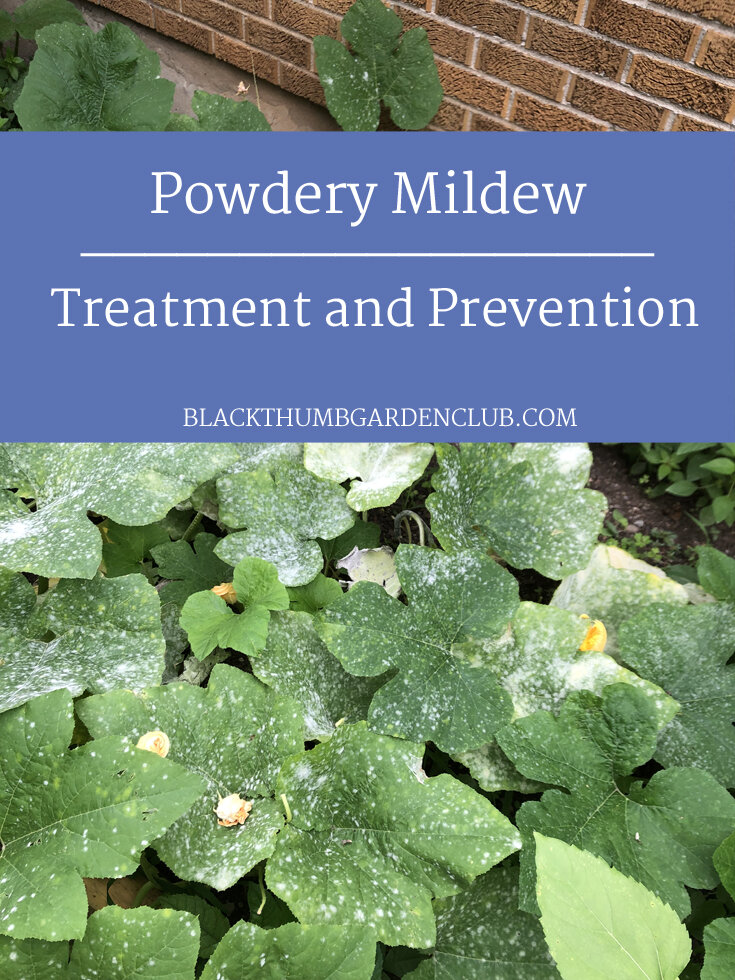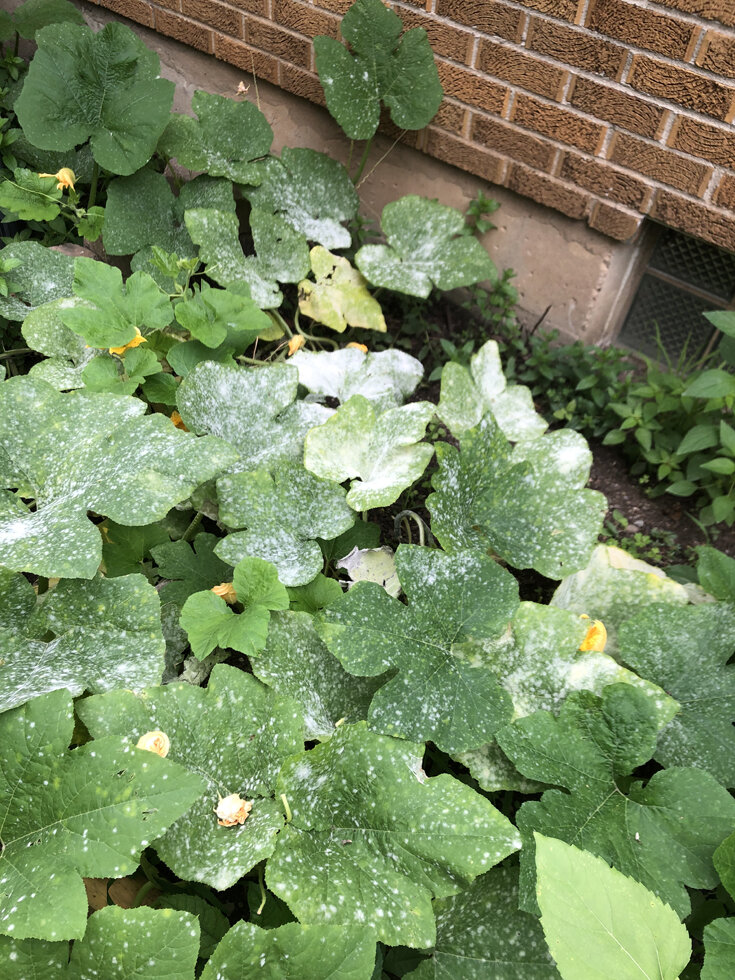Powdery Mildew and How to Save Your Plants When You Get It
Do your plants suffer from powdery mildew? Powdery mildew does not have to be a death sentence in your garden. In this post, we will teach you what it is, how to fix it, and how to prevent it from happening again. We will also cover the basics of how to apply Neem Oil!
What are the White Spots on My Pumpkins?
My cousin recently relocated to upstate New York, where she and her husband purchased their first home. I have been loving seeing her post pictures about the little garden that she started. A few weeks ago, I got a panicked text from her. Attached was a photo of what otherwise appeared to be a healthy pumpkin plant, with the exception of the white spots growing on her pumpkins. The next text that I got said, “What are these white spots on my pumpkins?”
She went on to share with me what she learned from her quick internet search… which wasn’t much. We spent the rest of the week exchanging texts. I gave her advice and then she followed through before asking me more questions. I felt her pain. Just a few years ago, I was her. I was the one panicked over white spots on my pumpkin leaves. I was the one doing quick internet searches and being so confused by what I found. I was the one wishing I could talk to someone about my gardening questions.
And then, that’s when it hit me- hello, I have a blog dedicated to helping gardeners of all abilities learn the valuable skills they need to be successful in the garden! If I had this question and she had this question, other people surely have this question. And many more! So- I proudly introduce to you the newest topic in our blog line-up… Where you ask questions and we answer them- one by one!
And what better place to start than with this question- What are the white spots on my pumpkins? The answer: powdery mildew.
Don’t worry, I’m not going to stop there. I’m going to teach you what causes it, how to fix it, and how to prevent it. And give you some clever tools to help!
Powdery mildew on my cousin’s pumpkin plants
What is Powdery Mildew?
Powdery mildew is a fungus that grows on plants when conditions are right… think the typical conditions that cause mildew- hot and wet. That doesn’t necessarily mean that you have to live in a humid place to get it. Heavy rain or poor overhead watering practices can also lead to powdery mildew.
Powdery mildew is pretty easy to identify. It appears as white or gray spots or patches on the leaves of plants. Powdery mildew can infect just about any plant, not just those found in your veggie garden. However, some plants are a bit more prone to getting it. I always think of squash and similar plants as being frequent victims. This includes pumpkins and cucumbers. Tomatoes and beans can be prone to powdery mildew as well as some common landscape plants.
I have a crepe myrtle in my front yard that currently has a touch of powdery mildew. A representative from my lawn care company came to assess my yard and let me know that he could treat it for the low low price of $65.99. I laughed. He looked confused. I said I would take care of it myself for a much lower price. I don’t think he believed me.
The powdery mildew on my crepe myrtles
There are lots of things that you can do to prevent powdery mildew, but if those prevention methods fail and you find you have an infection in your garden, you need to treat it as soon as possible. There are three main reasons for this.
Number one: It spreads quickly and easily. At first it will spread from leaf to leaf and then from plant to plant.
Number two: If left untreated, it will lead to leaf drop… which mean the leaf will die. And if you have too many leaves on the same plant infected, the whole plant will die.
Leaf drop from a powdery mildew infection.
Number three: Even if your whole plant doesn’t die, it can lead the fruit of the plant to become bitter.
How to Prevent Powdery Mildew
Gardens are similar to people and prevention is often the best medicine. Because wet conditions can lead to the development and spread of powdery mildew, practicing good watering methods is the best preventative method you can use.
What does “good watering methods” mean? This means that you water the base of the plant rather the leaves. If you use a drip irrigation system or a soaker hose to water your garden, then you have this covered. If you are like me and prefer to water via a hose, then be sure to place the nozzle of the hose close to stem and avoid the leaves. Also, water in the morning so that your plant has a chance to dry completely in the sun.
Powdery mildew can also thrive if you garden is overcrowded, so don’t be afraid to prune if necessary. This will allow for better air circulation, which allows plants to dry fully, which prevents powdery mildew.
You can also purchase plants that have been bred to be resistant to powdery mildew. Simply look at the description of the plant on the seed packet, seed catalog, or on the sign next to the plant at the nursery and it should tell you if it is resistant to powdery mildew. However, don’t assume that just because a plant is resistant to powdery mildew that you still shouldn’t follow the prevention methods listed above.
Finally, treat you plant regularly with a fungicide. Hopefully, you are already treating your plants with a pest preventer. If you are like us and are using our favorite pest preventer, you are also using a fungicide. What is this magical potion, you ask? Neem Oil. Why? Let me tell you!
What is Neem Oil and Why is it so Awesome?
Neem Oil is 100% organic, so it is a definite plus for all types of gardeners. The oil comes from the seeds of the Indian Neem Tree, which, as the name applies, is native to India and other parts of Southeast Asia. Not only is Neem Oil great at preventing bugs from munching on your leaves and acting as a fungicide, but it is also a bactericide and a miticide. When applied regularly, it does wonders for your garden. Bless the soul of whoever discovered that oil from a seed could be so magical.
We buy our Neem Oil in concentrated form. For small-medium sized gardens, one bottle should last you a whole season. Simply mix the required amount with a gallon of water and spray on the plants in your garden. We recommend using a hand sprayer to save your hand muscles and your sanity.
When you spray, cover the whole plant- top and underside of the leaves, stems, fruit, you name it, you spray it. Spray until the oil is running off. We recommend spraying weekly. Be sure to spray after the sun has set, as the oil can cause your plant leaves to get sunburned and we don’t want that! Because Neem Oil is organic, you can spray on the day of harvest. However, personal experience has taught me not to spray my lettuce leaves on harvest day!
We always get a lot of questions about how to apply Neem Oil, so I’ve made a little video showing you how to do it!
How to Treat Powdery Mildew
Despite our best efforts to prevent it, sometimes we still end up with a case of powdery mildew. Don’t worry- you don’t need to pull the plant up and call it lost, there are still things that can be done to save your plant.
Neem Oil and Other Treatments
Treat as soon as possible with Neem Oil. Continue treating weekly until the problem clears up. If you feel that Neem Oil isn’t working, there are other fungicides that you can try, so go ahead and give them a go if needed. Some gardening old wives tales (or would it be old gardening wives tales?) say that if you spray the plant with baking soda (1 teaspoon) and water (1 quart) or milk (1 part) and water (2 parts) you can also cure a plant of powdery mildew.
Prune
If the powdery mildew infection is bad enough, prune off the affected plant parts. Do NOT compost- powdery mildew can survive in compost heaps and will continue to curse your garden. In my cousin’s case, she removed the affected parts of her pumpkin and two new vines began to grow. Plants are pretty resilient! At the end of the year, do not put any part of the plant into the compost either, even if you managed to cure the mildew.
What Questions Do You Want Answered?
Now it's your turn. What problems have you dealt with in your garden? Do you have pictures to share? What would you like your fellow club members to know about dealing with it? What are you dealing with and can we help you problem solve?
Comment below, email us (blackthumbgardenclub@gmail.com), or pop on over to our Facebook group to ask your gardening questions… we would love to tailor our future blog posts to YOUR needs.
This post contains affiliated links… happy shopping!
Mariah Petrosino
lives in San Antonio with her daughter and husband. She is the Co-founder and Co-author of Black Thumb Garden Club and the Black Thumb Garden Club Workbook.
Mariah is passionate about learning to grow new heirloom varieties in her garden, working with people with developmental disabilities, and going on adventures with her family.





